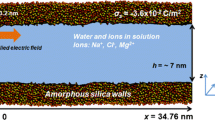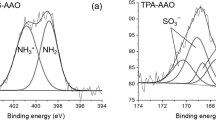Abstract
In an aqueous solution, the surface of inorganic nanochannels acquires charges from ionization, ion adsorption, and ion dissolution. These surface charges draw counter-ions toward the surface and repel co-ions. In the presence of a concentration gradient, counter-ions are transported through nanochannels much more easily than co-ions, which results in a net charge migration of one type of ions. The Gibbs free energy of mixing, which forces ion diffusion, thus can be converted into electrical energy by using inorganic ion-selective nanochannels. Silica nanochannels with heights of 4, 26, and 80 nm were used in this study. We experimentally investigated the power generation from these nanochannels placed between two potassium chloride solutions with various combinations of concentrations. The power generation per unit channel volume increases when the concentration gradient increases, and also increases as channel height decreases. The highest power density measured was 7.7 W/m2. Our data also indicate that the energy conversion efficiency and the ion selectivity increase with a decrease of concentrations and channel height. The best efficiency obtained was 31%. Power generation from concentration gradients in inorganic ion-selective nanochannels could be used in a variety of applications, including micro batteries and micro power generators.









Similar content being viewed by others
References
Audinos R (1983) Inverse electrodialysis: study of electric energy obtained starting with two solutions of different salinity. J Power Sources 10:203–217
Bard AJ, Faulkner LR (2001) Electrochemical methods. John Wiley & Sons, Inc., Hoboken
Beckwith TG, Marangoni RD, Lienhard JH (1993) Mechanical measurements, 5th edn. Addison-Wesley Publishing Company, New York
Bıyıkoğlu A (2005) Review of proton exchange membrane fuel cell models International. J Hydrogen Energy 30:1181–1212
Bocquet L, Charlaix E (2010) Nanofluidics, from bulk to interfaces. Chem Soc Rev 39:1073–1095
Bregman JI, Braman RS (1965) Inorganic ion exchange membranes. J Colloid Sci 20:913–922
Chen CH, Santiago JG (2002) A planar electroosmotic micropump. J Microelectromech Syst 11:672–683
Cheng LJ, Guo LJ (2007) Rectified ion transport through concentration gradient in homogeneous silica nanochannels. Nanoletters 7:3165–3171
Chobana ER, Markoski LJ, Wieckowski A, Kenis PJA (2004) Microfluidic fuel cell based on laminar flow. J Power Sources 128:54–60
Choi YS, Kim SJ (2009) Electrokinetic flow-induced currents in silica nanofluidic channels. J Colloid Interface Sci 333:672–678
Chu KL, Shannon MA, Masela RI (2006) An improved miniature direct formic acid fuel cell based on nanoporous silicon for portable power generation. J Electrochem Soc 153:A1562–A1567
Deng Y, Wang D, Xiao W, Jin X, Hu X, Chen GZ (2005) Electrochemistry at conductor/insulator/electrolyte three-phase interlines: a thin layer model. J Phys Chem B 109:14043–14051
Długołecki P, Nymeijer K, Metz S, Wesslinga M (2008) Current status of ion exchange membranes for power generation from salinity gradients. J Membr Sci 319:214–222
Fair JC, Osterle JF (1971) Reverse electrodialysis in charged capillary membranes. J Chem Phys 54:3307–3316
Gross RJ, Osterle JF (1968) Membrane transport characteristics of ultrafine capillaries. J Chem Phys 49:228–234
Heitner-Wirguin C (1996) Recent advances in perfluorinated ionomer membranes: structure, properties, and applications. J Membr Sci 120:1–33
Hornibrook WJ, Janz GJ, Gordon AR (1942) The thermodynamics of aqueous solutions of potassium chloride at temperatures from 15–45° from e.m.f. measurements on cells with transference. J Am Chem Soc 64:513–516
Hostetler PB, Truesdell AH, Christ CL (1967) Activity coefficients of aqueous potassium chloride measured with a potassium-sensitive glass electrode. Science 155:1537–1539
Hunter RJ (1981) Zeta potential in colloid science. Academic Press, New York
Janata J (2009) Principles of chemical sensors, 2nd edn. Springer, New York
Karnik R, Castelino K, Fan R, Yang P, Majumdar A (2005) Effects of biological reactions and modifications on conductance of nanofluidic channels. Nanoletters 5:1638–1642
Karnik R, Duan C, Castelino K, Daiguji H, Majumdar A (2007) Rectification of ionic current in a nanofluidic diode. Nanoletters 7:547–551
Lakshminarayanaiah N (1969) Transport phenomena in membranes. Academic Press, New York
Larminie J, Dicks A (2003) Fuel cell systems explained, 2nd edn. John Wiley & Sons, Inc, Hoboken
Lu MC, Satyanarayana S, Karnik R, Majumdar A, Wang CC (2006) A mechanical-electrokinetic battery using a nano-porous membrane. J Micromech Microeng 16:667–675
MacInnes DA (1919) The activities of the ions of strong electrolytes. J Am Chem Soc 41:1086–1092
Majumdar A, Tien CL (1998) Micro power devices. Microsc Thermophys Eng 2:67–69
Mehta V, Cooper JS (2003) Review and analysis of PEM fuel cell design and manufacturing. J Power Sources 114:32–53
Pattle RE (1954) Production of electric power by mixing fresh and salt water in the hydroelectric pile. Nature 174:660
Pennathur S, Eijkel JCT, van den Berg A (2007) Energy conversion in microsystems: is there a role for micro/nanofluidics? Lab Chip 7:1234–1237
Ponce de Leon C, Frias-Ferrer A, Gonzalez-Garcia J, Szanto DA, Walsh FC (2006) Redox flow cells for energy conversion. J Power Sources 160:716–732
Rajan KS, Boies DB, Casolo AJ, Bregman JI (1966) Inorganic ion-exchange membranes and their application to electrodialysis. Desalination 1:231–246
Smitha B, Sridhar S, Khan AA (2005) Solid polymer membranes for fuel cell applications—a review. J Membr Sci 259:10–26
Stein D, Kruithof M, Dekker C (2004) Surface-charge-governed ion transport in nanofluidic channels. Phys Rev Lett 93:035901(1–4)
Suda F, Matsuo T, Ushioda D (2007) Transient changes in the power output from the concentration difference cell (dialytic battery) between seawater and river water. Energy 32:165–173
Tasaka M, Kiyono R, Taniguchi A (2001) Experimental evaluation of single ion activities. J Membr Sci 185:245–251
Turek M, Bandura B (2007) Renewable energy by reverse electrodialysis. Desalination 205:67–74
van der Heyden FHJ, Bonthuis DJ, Stein D, Meyer C, Dekker C (2007) Electro-chemo-mechanical energy conversion in nanofluidic channels. Nanoletters 7:1022–1025
Veerman J, Saakes M, Metz SJ, Harmsen GJ (2009a) Reverse electrodialysis: performance of a stack with 50 cells on the mixing of sea and river water. J Membr Sci 327:136–144
Veerman J, de Jong RM, Saakes M, Metz SJ, Harmsen GJ (2009b) Reverse electrodialysis: comparison of six commercial membrane pairs on the thermodynamic efficiency and power density. J Membr Sci 343:7–15
Vlassiouk I, Smirnov S, Siwy Z (2008) Ionic selectivity of single nanochannels. Nanoletters 8:1978–1985
Weinstein JN, Leitz FB (1976) Electric power from differences in salinity: the dialytic battery. Science 191:557–559
Whalen S, Thompson M, Bahr D, Richards C, Richards R (2003) Design, fabrication and testing of the p3 micro heat engine. Sens Actuators A 104:290–298
Acknowledgments
The authors would like to thank the Basic Energy Sciences of the US Department of Energy for their support of this research. This work was supported by the Korea Research Foundation Grant funded by the Korean Government (KRF-2008-357-D00021).
Author information
Authors and Affiliations
Corresponding author
Additional information
Dong-Kwon Kim and Chuanhua Duan contributed equally to this work.
Appendices
Appendix 1
1.1 Fabrication process for silica nanochannels
The whole process started with a silicon wafer. As the first step, nanochannels were patterned on the wafer by standard photolithography. Lam 4, an RIE (Reactive Ion Etching) instrument from Lam Inc., was used for the nanochannel etching. Two reactive gases were used during this step. SF6 plasma was used to remove the native oxide layer on top of the silicon wafer and Cl2 plasma was used to etch the silicon. By applying low power (50 W), we were able to achieve a slow etching rate as well as small surface roughness. After etching the nanochannels, microchannels for the flow passage were defined and etched. The microchannels are around 1-cm long and 500-μm wide. A standard DRIE recipe was run for 20 min to etch 60-μm deep microchannels. The top surface was then deposited as a 1-μm thick oxide layer using PECVD (plasma enhanced chemical vapor deposition) at 350°C. This layer serves as a protection layer for the following reservoir etching. Reservoirs were pattered from the back side and DRIE was again used to form straight etch-through reservoirs. The 1-μm thick oxide layer was removed by 5:1 HF solution after this step. Wafer was then sent into a furnace to grow thermal oxide at 1,000°C. 200 nm dry oxide and 300 nm wet oxide were grown uniformly on all wafer surfaces. The total 500-nm thick thermal oxide provides a good insulation layer for later electrical measurement. After that, this silicon wafer and a new Pyrex wafer were cleaned in hot piranha solution and blow-dried by nitrogen. Wafer-wafer anodic bonding was used to bond these two wafers together. The bonding process took around 30 min at 400°C and 600 V. The bonded wafer was then placed in a PECVD chamber with reservoir side up to grow a 3-μm thick PECVD oxide on all exposed surface. This additional oxide layer prevents electrical leakage from any sharp corner. To prevent solution contamination, a 1-μm thick PDMS was also coated on this surface using a stamp-stick technique.
Appendix 2
2.1 Validity of Eq. 2
In the present study, the electric potential generated in the nanochannel, V channel, is not directly measured but calculated from measured V app via Eq. 2. However, the error introduced by this indirect approach is less than 1% because Eq. 2 accurately predicts E redox when the current from the nanochannels, I channel, is much smaller than the exchange current of the Ag/AgCl electrodes, as shown below.
The real redox potential E redox is given by:
where E eq and η are the thermodynamic value of E redox and the overpotential, respectively (Bard and Faulkner 2001). E eq is simply given from the Nernst equation as:
The overpotential η is the potential difference between the thermodynamically determined potential and the real potential. This overpotential is caused by the limited rate of electrochemical reactions on the electrodes. The overpotential is given from the Butler–Volmer equation as:
where i 0, A, and α are the exchange current density of the electrodes, the surface area of the electrode–solution interface, and the transfer coefficient, respectively.
In the present study, the cylindrical Ag/AgCl electrodes were dipped into the solutions. The diameter D of the electrodes and the dipping length L were about 0.8 and 2 mm, respectively. Therefore, the surface area of the electrode–solution interface is:
The exchange current density i 0 of the Ag/AgCl electrodes is known to be higher than 10−3 A/cm2 and the transfer coefficient is close to 0.5 (Deng et al. (2005)). As shown in Fig. 3, I channel is much smaller than 10 nA in the present study. As a result, from Eq. 15, the overpotential η is smaller than 0.05 mV. Therefore, the overpotential is much smaller than E eq (>5 mV) and the redox potential E redox is approximately equal to the thermodynamic potential E eq:
In Table 3, the redox potentials calculated from Eq. 17 also are compared with the experimental values presented in Janata (2009). The results indicate that Eq. 17 can predict the redox potential with a relative error of less than 1%.
Appendix 3
3.1 Uncertainty analysis
To analyze the errors, an uncertainty analysis was conducted. The measurement error consists of the bias error and the precision error. The uncertainty U is given as follows (Beckwith et al. 1993):
where B and P are bias uncertainty and precision uncertainty, respectively. The precision uncertainty is determined by:
where \( t_{{ 9 5 {\text{\% ,v}}}} \), S, v, N, \( \bar{x} \) and x i are t-distribution for a confidence level of 95%, standard deviation, degree of freedom, data number, sample mean, and measured value of a particular experiment.
Rights and permissions
About this article
Cite this article
Kim, DK., Duan, C., Chen, YF. et al. Power generation from concentration gradient by reverse electrodialysis in ion-selective nanochannels. Microfluid Nanofluid 9, 1215–1224 (2010). https://doi.org/10.1007/s10404-010-0641-0
Received:
Accepted:
Published:
Issue Date:
DOI: https://doi.org/10.1007/s10404-010-0641-0




